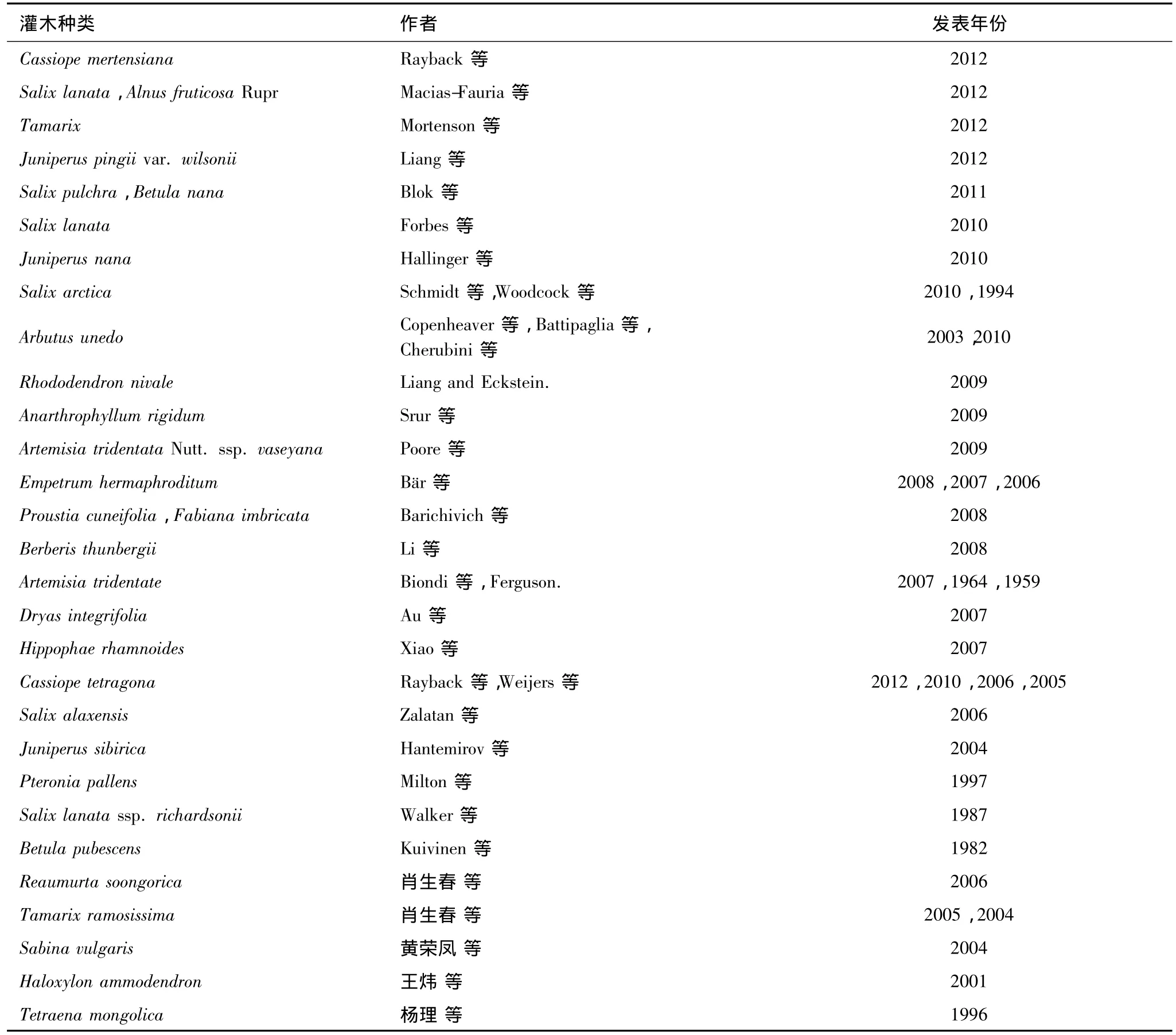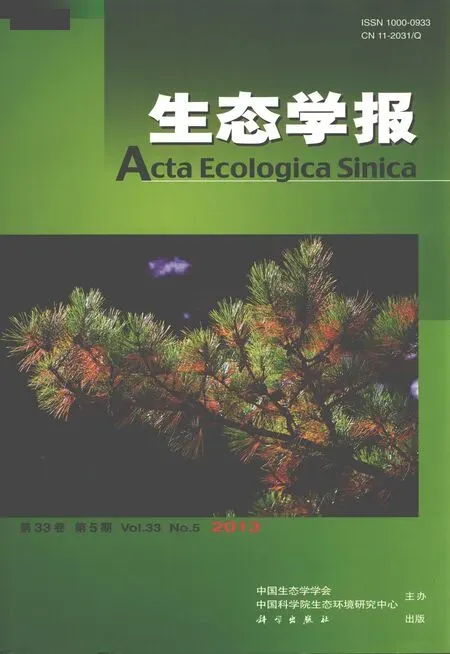灌木年轮学研究进展
芦晓明,梁尔源
(1.中国科学院环境变化与地表过程重点实验室,中国科学院青藏高原研究所,北京 100101;2.中国科学院大学,北京 100049)
树木年代学创立于20世纪20年代[1],其早期研究对象均为乔木树种。直至20世纪五六十年代,Ferguson将三齿蒿(Artemisia tridentata)作为研究对象,才开启了灌木年轮研究的先河[2-3]。灌木年轮普遍较窄,不少种类存在年轮界限不清的现象。尤其是,较高比率的缺失轮、霜轮和伪年轮出现,以及茎干不同部分形成层活动和生长不同步等问题为灌木年轮的交叉定年带来很大的困难[4-10]。鉴于以上原因,20世纪90年代前灌木的年轮研究发展相对缓慢。近十年来,越来越多的生态学者把灌木的生长和分布范围的变化作为对全球气候变化响应的敏感性生态指标。尤其是,灌木年轮在拓展传统乔木树轮网络方面的巨大潜力被越来越多的树轮研究学者所认同。因此,有关灌木的年轮研究也受到日益关注[11]。然而,据不完全统计,在目前已被用于树木年代学研究的约700多个树种中(Dendrochronology species database),仅有30种灌木种类,且多集中于环北极苔原带(图1,表1)。
本文拟围绕过去几十年来的研究,对灌木年轮研究方法和已取得的成果作简要介绍,旨在强调开展青藏高原寒区旱区灌木年轮研究的必要性。需要指出的是,本文探讨的是超出了乔木生长范围,主要以灌木生长型存在的灌木种类。生长在树线之上或以北,以灌木生长型存在的乔木树种,如高纬度地区的黑云杉[12],并不包含于本文讨论范围中。此外,考虑到寒区、旱区灌木种类在扩展目前树轮研究网络方面的潜力,以及目前国内外所开展的灌木年轮研究的主要地区,本文将分环北极高纬度,干旱、半干旱以及高海拔区3个主要区域来综述灌木年轮研究的主要进展。另外,还简要介绍了灌木与乔木年轮研究方法的主要不同点。

图1 世界范围内灌木年轮气候研究主要样点分布图Fig.1 Map showing dendrochronological sites for shrub species
1 灌木年轮研究方法
灌木年轮研究遵循树木年代学的基本原理与方法[13-15]。这里只强调灌木与乔木年轮研究方法上的几点不同之处。灌木年轮较窄,存在高频率的缺失轮,交叉定年的难度较大。目前,大多数灌木年轮研究都是采集灌木茎干基部的圆盘样本来进行研究。在极端环境条件下,灌木的茎干从基部至顶端,一些部分的维管形成层的活动可能会逐渐停止,因此只采集茎干基部或其它部分的样本无法准确地进行交叉定年。鉴于这一问题,灌木年轮研究中需要采用系列茎干取样法(series section),即沿着灌木茎干从基部至顶端每隔几厘米至几十厘米采集圆盘[8]。最终通过对灌木个体不同部位以及不同灌木个体之间茎干基部圆盘分别进行的交叉定年,建立连续可靠的年轮宽度时间序列。需要说明的是,由于大多数灌木匍匐生长,茎干为硬压木或伸张木,实验中一般选择与硬压木或伸张木垂直的两个方向对其进行交叉定年,以避免硬压木与伸张木对定年的影响[16]。另外,与乔木的年轮宽度时间序列相比,有些灌木年轮宽度的年龄变化趋势不明显[17]。

表1 应用于灌木年轮研究主要灌木种类、作者及发表年份(按倒序排列)一览表Table 1 A list of shrub species for dendrochronological studies as well as their publication years and authors
除年轮宽度外,灌木作为控制实验的对象在近期也受到越来越多的关注。尤其在模拟增温对环北极灌木生长发育的影响方面,目前已取得了一系列成果[18-19]。这类研究将从生理机制上揭示灌木生长对气候变化的响应特征。此外,灌木年轮中碳氧同位素的研究也得到广泛应用。灌木年轮宽度、同位素、木材解剖结构等多种方法相结合将是探讨灌木对极端环境适应机制的主要途径[20-21]。
2 灌木年轮研究进展
2.1 环北极高纬度地区灌木年轮研究
全球变暖已对陆地生态系统造成了显著影响,其中环北极苔原生态系统是对全球变暖响应最敏感的地区之一[22]。环北极树线之外的苔原带,气候条件严酷,超出了乔木生长的所耐受的生理阈值条件,但是却分布着一些灌木和矮灌木。这些灌木和矮灌木的生长轮(年轮)是了解环北极苔原带过去高分辨率气候变化历史的重要代用指标。此外,高纬度灌木生长对气候变化的适应机制以及全球变化对灌木分布和生长的影响都已成为环北极地区备受关注的生态问题。目前,已有约14种生长于环北极高纬度区的灌木用于年轮气候学研究。这些灌木都有生长轮的形成,且大部分可进行交叉定年,展示出良好的树木年代学研究潜力[4,7,9]。
环北极一带灌木年轮研究重点主要包括3个方面。第一,揭示影响极地地区灌木生长的环境因子和生理生态特性[7,9,20,23-27]。基于年轮特征的分析,初夏温度是环北极灌木Salix pulchra和Betula nana生长的主要限制因子[28];而灌木Juniperus nana的生长则指示了当地6—7月份的温度和冬季积雪的变化[10]。此外,环北极四棱岩须(Cassiope tetragona)的生长则主要指示了极地7月的温度变化,这种气候-生长关系在持续了7年时间的温度控制实验中也得到了证实[19,29]。第二,利用灌木重建区域性的温度[5,19-20,30-31]降水变化[4-6,30-31]和气候极端事件的发生历史[4,32]。例如,Weijers等利用环北极矮灌木四棱岩须的茎干每年生长长度的变化重建了过去169a来当地7月份温度的变化历史,这也是目前为止利用矮灌木所重建的环北极最长的气候序列[29]。Woodcock和Bradley以及Hantemirov等通过高纬度地区灌木年轮中霜轮的出现推测过去的火山喷发及其造成的低温事件[4,32]。第三,了解近几十年全球变化是否对环北极一带灌木种群的分布范围产生了影响[10,28,33-34]。有研究表明,近几十年来,北极地区温度上升的幅度已超过全球平均水平[35],并造成了灌木种群分布范围的扩张[10,33,36-39]和物种丰富度的增加[40];相应地,环北极一带灌木生长高度增加与分布范围的扩张则会促使土壤温度升高,破坏冻土层,从而加深土壤活动层,进一步加剧区域升温[41]。环北极地区的控制实验也证明,温度上升有利于落叶灌木的生长[18]。然而,也有学者认为高纬度苔原生态系统中灌木覆盖度的增加会减少灌木冠层下物种的多样性[42]。Macias-Fauria等通过对环北极灌木Salix lanata与Alnus fruticosa近50年的生长变化研究,揭示了灌木的生产力与春季晚期海冰变化和大空间尺度上大气环流的关系[43]。此外,Tape等发现Alnusviridis ssp.Fruticosa分布范围的扩张与景观异质性有关,处于扩张的群落具有较稳定的斑块和较宽的年轮,且对春夏温度变化的响应也更为敏感[36];随后的一些研究则进一步证实了灌木扩张的景观异质性[44-46]。基于长期的样地调查数据以及全球苔原生态系统61个控制实验结果的整合分析,Elmendorf等得出以下结论:近二十年来在全球变暖背景下,植被对变暖响应与研究区的夏季温度、土壤湿度和实验周期有关,且处于环境温度相对较高区域的维管植物,其高度、丰富度会显著增加[38,47]。在未来的几十年中,高纬度地区温度还可能将持续上升[35],因此灌木年轮学将在未来环北极地区灌木生长变化、种群扩张等方面的研究中继续发挥重要作用。
2.2 干旱、半干旱区的灌木年轮研究
水分是控制干旱、半干旱区生态系统结构与功能的主要环境因子。早在20世纪90年代,Milton等在南非的Karoo地区通过对Pteronia pallens年轮宽度变化和基径变化的比较,揭示其每年都有单一的年轮形成,并证实了轮宽变化可以指示降雨变化[48]。Biondi等利用北美大盆地地区三齿蒿年轮中放射性14C的变化,结合对样本的交叉定年,证实其年轮中14C的峰值年与1963—1964年原子弹爆炸高峰期具有很好一致性。这说明三齿蒿每年都有年轮的形成,为今后利用三齿蒿年轮重建当地气候变化提供了良好的基础[49]。Rayback等对美国雷尼尔山国家公园(Mt.Rainier National Park)的白石南岩须(Cassiope mertensiana)的生长和繁殖状况(1963—2004)的分析,揭示了上年4和6月份的最高温对生长的影响,而当年7月份最高温对于繁殖有显著影响[50]。南美巴塔哥尼亚草原上有大范围的灌木分布,其中一些灌木种类形成清晰的年轮[51];在沿阿根廷的南北纬度带上,Srur等通过灌木Anarthrophyllum rigidum的年轮分析,证实了过去20—30a的区域气候变化对灌木径向生长的影响[52]。而地中海地区伪年轮和缺失轮发生的频率较高[53]。例如,Copenheaver等通过对草莓树(Arbutus unedo)灌木木材解剖和年轮生长特征的分析,探讨伪年轮的形成机制,揭示了夏季干旱是导致灌木伪年轮形成的主要原因;另外,与老树相比,幼树根系相对较浅,水分利用状况较差,更易产生伪年轮[54]。此外,Battipaglia等也以草莓树灌木为研究对象,通过伪年轮的发生来重建地中海厄尔巴岛地区季节气候变化,尤其是降水变化历史[21]。另外,学者们利用树木年代学的研究手段,分析了北美地区日本小蘖(Berberis thunbergii)的入侵机制和其对气候变化的响应[55],以及当地气候变化和水文特征对入侵种柽柳(Tamarix)更新和生长的影响[56],扩展了灌木年轮研究的范畴。
迄今,我国灌木年轮研究主要集中于干旱、半干旱区。肖生春等分析了沙漠柽柳灌木的生长特征,并利用内蒙古额济纳西居延海柽柳年轮宽度的变化,重建了过去100年来居延海5—8月份的湖泊水位的变化历史[57-58]。另外,肖生春等还分析了不同坡向的荒漠红砂对当地水热条件的响应,根据其年龄特征的分布格局,对黄土高原西部水土流失的防治提供了宝贵的指导意见[59]。杨理等、王炜等、和黄荣凤等则分别分析了沙漠或沙地灌木四合木、梭梭和沙地柏灌木对降水和气温变化的响应特征[60-62]。总之,在干旱、半干旱带进行灌木树轮气候的研究具有很大的潜力,灌木年轮不仅可以用来重建过去的气候变化历史,也可以根据灌木生长对环境的适应性特征为当地进行生态屏障的建设提供有价值的信息。
2.3 高山灌木的年轮研究
高山灌木年轮气候学研究主要集中于美洲山区和青藏高原地区。尤其值得提出的是,青藏高原的乔木森林主要分布于高原边缘山地,过去的树木年代学研究也只关注这些地区的树轮气候重建[63-71],而灌木在青藏高原的分布范围则更为广泛[17,72]。Xiao等通过沙棘 (Hippophae rhamnoides)灌木的年轮宽度重建了祁连山西部七一冰川1950至2003年的雪线变化。其原理是灌木的生长和冰川的进退都受到气候变化的影响,从而可以通过灌木年轮的变化来了解到过去几十年来气候变化和雪线波动历史[73]。青藏高原东南部是国际上杜鹃花属植物的分布中心之一,且往往分布在树线之上,是青藏高原地区最值得开展年轮研究的灌木种类[17]。我国学者以藏东南作求普冰舌前的杜鹃灌木为(海拔4450—4500m)研究材料,证实杜鹃灌木具有清晰的年轮结构,不同植株之间可以进行交叉定年,且年轮宽度变化具有一定的敏感度,展示了树木年代学研究潜力。进一步的分析显示,杜鹃灌木的生长记录了与藏东南林线急尖长苞冷杉相似的气候信号,即受到上年11月和当年夏季最低温的影响[17];最近,Liang等在西藏纳木错周边对香柏灌木(海拔4740—4780m)进行研究,建立了一条250a的灌木年轮宽度年表。此研究首次把青藏高原周边的树轮研究网络扩展到高原内部。与环北极的矮灌木不同的是,纳木错香柏灌木的生长主要受5—6月份的土壤湿度限制,5—6月份的高温由于可以增加土壤水分的蒸发而与香柏的年轮宽度序列之间呈现显著的负相关关系[72]。智利中北部山区是树轮气候学研究的空白区域,Barichivich等利用灌木年轮宽度来指示过去两个世纪以来厄尔尼诺(ENSO)和太平洋十年涛动(PDO)的变化[74]。Poore等研究了气候变化对北美高山地区三齿蒿的生长及其种群的影响,并分别分析了1969至2007年温度、降水和积雪厚度与三齿蒿年轮宽度变化之间的关系[75]。以上研究展示了高山灌木在指示过去气候变化方面的优势与独特性。然而,相比于环北极地区,高山灌木的树木年代学研究并没有获得足够的重视。
3 展望
过去几十年中,灌木年轮研究扩展了以乔木为主的树轮研究网络,尤其在重建北极、亚北极和高海拔等地区气候变化方面取得了一系列研究成果。在全球变暖的背景下,灌木年轮研究将日益受到关注。然而,除了环北极地区,其他地区尚未建立大空间尺度上的灌木年轮网络。青藏高原作为地球的第三极,具有建立大空间尺度上灌木年轮网络的潜力,但该地区高山灌木的年轮研究直到目前并未引起足够的重视。青藏高原高山灌木的生长是如何适应极端环境条件的?全球变暖的背景下,青藏高原高山灌木的分布和生长正在发生那些变化?这些都是值得深入研究的问题。因此,今后的研究应充分发挥高山灌木年轮研究的优势,将目前的树轮研究网络扩展至更高的海拔和高原内部。
[1] Douglass A E.Evidence or climatic effects in the annual rings of trees.Ecology,1920,1(1):24-32.
[2] Ferguson C W.Growth rings in woody shrubs as potential aids in archaeological interpretation.Kiva,1959,25(2):24-30.
[3] Ferguson C W.Annual rings in big sagebrush,Artemisia tridentata.Papers of the Laboratory of Tree-ring Research no.1.Tucson:University of Arizona Press,1964:1-103.
[4] Woodcock H,Bradley R S.Salix arctica(Pall.):its potential for dendroclimatological studies in the high arctic.Dendrochronologia,1994,12(1):11-22.
[5] Rayback S A,Henry G H R.Dendrochronological potential of the Arctic dwarf-shrub Cassiope tetragona.Tree-Ring Research,2005,61(1):43-53.
[6] Zalatan R,Gajewski K.Dendrochronological potential of Salix alaxensis from the Kuujjua River area.Western Canadian Arctic Tree-Ring Research,2006,62(2):75-82.
[7] Au R,Tardif J C.Allometric relationships and dendroecology of the dwarf shrub Dryas integrifolia near Churchill,subarctic Manitoba.Canadian Journal of Botany,2007,85(6):585-597.
[8] Kolishchuk V G.Dendroclimatological study of prostrate woody plants//Cook E R,Kairiukstis L A,eds.Methods of dendrochronology:applications in the environmental sciences.Kluwer:London,1990:51-55.
[9] Bär A,Bräuning A,Löffler J.Dendroecology of dwarf shrubs in the high mountains of Norway methodological approach.Dendrochronologia,2006,24(1):17-27.
[10] Hallinger M,Manthey M,Wilmking M.Establishing a missing link:warm summers and winter snow cover promote shrub expansion into alpine tundra in Scandinavia.New Phytologist,2010,186(1):890-899.
[11] Naito A T,Cairns D M.Relationships between Arctic shrub dynamics and topographically derived hydrologic characteristics.Environmental Research Letters,2011,6(4):045506.doi:10.1088/1748-9326/6/4/045506.
[12] Gamache I,Payette S.Height growth response of tree line black spruce to recent climate warming across the forest-tundra of eastern Canada.Journal of Ecology,2004,92(1):835-845.
[13] Fritts H C.Tree rings and climate.London:Academic Press,1976.
[14] Cook E R,Kairiukstis L A.Methods of dendrochronology:applications in the environmental sciences.Dordrecht:Kluwer,1990:97-104.
[15] Schweingruber F H.Tree rings and environment,dendroeology.Berne:Paul Haupt,1996.
[16] Stokes M A,Smiley T L.An introduction to tree-ring dating.Chicago:University of Chicago Press,1968.
[17] Liang E Y,Eckstein D.Dendrochronological potential of the alpine shrub Rhododendron nivale on the south-eastern Tibetan Plateau.Annals of Botany,2009,104(4):665-670.
[18] Walker M D,Wahren C H,Hollister R D,Henry G H R,Ahlquist L E,Alatalo J M,Bret-Harte M S,Calef M P,Callaghan T V,Carroll A B,Epstein H E,Jonsdottir I S,Klein J A,Magnusson B,Molau U,Oberbauer S F,Rewa S P,Robinson C H,Shaver G R,Suding K N,Thompson C C,Tolvanen A,Totland O,Turner P L,Tweedie C E,Webber,P J,Wookey P A.Plant community responses to experimental warming across the tundra biome.Proceedings of the National Academy of Sciences of the United States of America,2006,103(5):1342-1346.
[19] Weijers S,Alsos I G,Eidesen P B,Broekman R,Loonen M J J E,Rozema J.No divergence in Cassiope tetragona:persistence of growth response along a latitudinal temperature gradient and under multi-year experimental warming.Annals of Botany,2012,110(3):653-665.
[20] Rayback S A,Henry G H R.Reconstruction of summer temperature for a Canadian High Arctic site from retrospective analysis of the dwarf shrub,Cassiope tetragona.Arctic,Antarctic and Alpine Research,2006,38(2):228-238.
[21] Battipaglia G,Micco V D,Brand W A.Variations of vessel diameter and δ13C in false rings of Arbutus unedo L.reflect different environmental conditions.New Phytologist,2010,188(4):1099-1112.
[22] ACIA.Arctic climate impact assessment.Cambridge:Cambridge University Press,2005.
[23] Walker D A.Height and growth rings of Salix lanata ssp.richardsonii along the coastal temperature gradient of northern Alaska.Canadian Journal of Botany,1987,65(5):988-993.
[24] Bär A,Bräuning A,Löffler J.Climate-growth relationships of the dwarf shrub species Empetrum hermaphroditum in the Norwegian Scandes.Trace-Tree Rings in Archaeology,Climatology and Ecology,2007,5:156-160.
[25] Bär A,Bräuning A,Löffler J.Ring-width chronologies of the alpine dwarf shrub Empetrum hermaphroditum from the Norwegian Mountains.International Association of Wood Anatomists Journal,2007,28(3):325-338.
[26] Bär A,Pape R,Bräuning A,Löffler J.Growth-ring variations of dwarf shrubs reflect regional climate signals in alpine environments rather than topoclimatic differences.Journal of Biogeography,2008,35(4):625-636.
[27] Schmidt N M,Baittinger C,Kollmann J,Forchhammer M C.Consistent dendrochronological response of the dioecious Salix arctica to variation in local snow precipitation across gender and vegetation types.Arctic,Antarctic,and Alpine Research,2010,42(4):471-475.
[28] Blok D,Sass-Klaassen U,Schaepman-Strub G,Heijmans M M P D,Sauren P,Berendse F.What are the main climate drivers for shrub growth in Northeastern Siberian tundra?Biogeosciences,2011,8(1):771-799.
[29] Weijers S,Broekman R,Rozema J.Dendrochronology in the High Arctic:July air temperatures reconstructed from annual shoot length growth of the circumarctic dwarf shrub Cassiope tetragona.Quaternary Science Reviews,2010,29(27/28):3831-3842.
[30] Kuivinen K C,Lawson M P.Dendroclimatic analysis of birch in South Greenland.Arctic and Alpine Research,1982,14(3):243-250.
[31] Rayback S A,Henry G H R,Lini A.Multiproxy reconstructions of climate for three sites in the Canadian High Arctic using Cassiope tetragona.Climate Change,2012a,114(3/4):593-619.
[32] Hantemirov R M,Gorlanova L A,Shiyatov S G.Extreme temperature events in summer in northwest Siberia since AD 742 inferred from tree rings.Palaeogeography,Palaeoclimatology,Palaeoecology,2004,209(1/4):155-164.
[33] Forbes B C,Fauria M M,Zetterberg P.Russian Arctic warming and‘greening’are closely tracked by tundra shrub willows.Global Change Biology,2010,16(5):1542-1554.
[34] Rundqvist S,Hedenas H,Sandstrom A,Emanuelsson U,Eriksson H,Jonasson C,Callaghan T V.Tree and shrub expansion over the past 34 years at the Tree-Line near Abisko.Sweden.Ambio,2011,40(6):683-692.
[35] IPCC.Climate Change 2007:Impacts,Adaptation and Vulnerability.Cambridge:Cambridge University Press,2007.
[36] Tape K,Sturm M,Racine C.The evidence for shrub expansion in Northern Alaska and the Pan-Arctic.Global Change Biology,2006,12(4),686-702.
[37] Tape K,Hallinger M,Ruess R W,Welker J M.Landscape heterogeneity of shrub expansion in Arctic Alaska.Ecosystems,2012,15(5):711-724.
[38] Elmendorf S C,Henry G H R,Hollister R D,Björk R G,Bjorkman A D,Callaghan T V,Collier L S,Cooper E J,Cornelissen J H C.Global assessment of experimental climate warming on tundra vegetation:heterogeneity over space and time.Ecology Letters,2012,15(2):164-175.
[39] Epstein H E,Raynolds M K,Walker D A,Bhatt U S,Tucker C J,Pinzon J E.Dynamics of aboveground phytomass of the circumpolar Arctic tundra during the past three decades.Environmental Research Letters,2012,7(1):015506.doi:10.1088/1748-9326/7/1/015506.
[40] Sturm M,Racine C,Tape K.Increasing shrub abundance in the Arctic.Nature,2001,411:546-547.
[41] Bonfils C J W,Phillips1 T J,Lawrence D M,Cameron-Smith P,Riley W J,Subin Z M.On the influence of shrub height and expansion on northern high latitude climate.Environmental Research Letters,2012,7(1):015503.doi:10.1088/1748-9326/7/1/015503.
[42] Pajunen A M,Oksanen J,Virtanen R.Impact of shrub canopies on understorey vegetation in western eurasian tundra.Journal:Journal of Vegetation Science,2011,22(5):837-846.
[43] Macias-Fauria M,Forbes B C,Zetterberg P,Kumpula T.Eurasian Arctic greening reveals teleconnections and the potential for structurally novel ecosystems.Nature Climate Change,2012,2(8):613-618.
[44] Myers-Smith I H,Forbes B C,Wilmking M,Hallinger M,Lantz T,Blok D,Tape K D,Macias-Fauria M.Shrub expansion in tundra ecosystems:dynamics,impacts and research priorities.Environmental Research Letters,2011,6(4):045509.doi:10.1088/1748-9326/6/4/045509.
[45] Naito A T,Cairns D M.Patterns and processes of global shrub expansion.Progress in Physical Geography,2011,35(4):423-442.
[46] Ropars P,Boudreau S.Shrub expansion at the forest-tundra ecotone:spatial heterogeneity linked to local topography.Environmental Research Letters,2012,7(1):015501.doi:10.1088/1748-9326/7/1/015501.
[47] Elmendorf S C,Henry G H R,Hollister R D,Björk R G,Boulanger-Lapointe N,Cooper E J,Cornelissen J H C,Day T A.Plot-scale evidence of tundra vegetation change and links to recent summer warming.Nature Climate Change,2012,2(8):453-457.
[48] Milton S J,Gourlay I D,Dean W R.Shrub growth and demography in arid Karoo,South Africa:inference from wood rings.Journal of Arid Environments,1997,37(3):487-496.
[49] Biondi F,Strachan S D J,Mensing S,Piovesan G.Radiocarbon analysis confirms the annual nature of sagebrush growth rings.The Arizona Board of Regents on behalf of the University of Arizona,2007,49(3):1231-1240.
[50] Rayback S A,Lini A,Berg D L.The dendroclimatological potential of an alpine shrub Cassiope Mertensiana,from Mount Rainier,WA,USA.Geografiska Annaler:Serises A,Physical Geography,2012,94(3):413-427.
[51] Golluscio R A,Sala O E.Plant functional types and ecological strategies in Patagonian forbs.Journal of Vegetation Sciences,1993,4(6):839-846.
[52] Srur A M,Villalba R.Annual growth rings of the shrub Anarthrophyllum rigidum across Patagonia:Interannual variations and relationships with climate.Journal of Arid Environments,2009,73(12):1074-1083.
[53] Cherubini P,Gartner B L,Tognetti R,Braker O,Schoch W,Innes J.Identification,measurement and interpretation of tree rings in woody species from mediterranean climates.Cambridge Philosophical Society,2003,78(1):119-148.
[54] Copenheaver C A,Gärtner H,Schäfer I,Vaccari F P,Cherubini P.Drought-triggered false ring formation in a medeterranean shrub.Botany,2010,88(6):545-555.
[55] Li J B,Xu C Y,Griffin K L,William S F.Dendrochonological potential of Japanese Barberry(Berberis thunbergii):a case study in the Black Rock Forest,New York.Tree-Ring Research,2008,64(2):115-124.
[56] Mortenson S G,Weisberg P J,Stevens L E.The influence of floods and precipitation on Tamarix establishment in Grand Canyon,Arizona:consequences for flow regime restoration.Biological Invasions,2012,14(5):1061-1076.
[57] Xiao S C,Xiao H L,Zhou M X,Si J H,Zhang X Y.Water level change of the west Juyan Lake in the past 100 years recorded in the tree ring of the shrubs in the lake banks.Journal of Glaciology and Geocryology,2004,26(5):557-562.
[58] Xiao S C,Xiao H L,Si J H,Liu F M.Growth characteristics of Tamarix ramosissima in arid regions of China.Acta Botanica Boreali-occidentalia Sinica,2005,25(5):1012-1016.
[59] Xiao S C,Xiao H L,Song Y X,Duan Z H,Lu M F.Dendrochronology study on response of Reaumurta soongorica.Journal of desert research,2006,26(4):547-552.
[60] Yang L,Yang C,Yang M C,Zhang H R.The study on relationship between Tetraena mongolica maxim growth and precipitation,temperature.Acta Scienriarum Naturialium Unverisitatia Neimenggol,1996,27(6):816-820.
[61] Wang W,Liang C Z,Zhu Z Y,Liu L F.Studies on the measuring method of growth rings of Haloxylon ammodendron and its growing dynamics.Journal of Arid Land Resources and Environment,2001,15(1):67-74.
[62] Huang R F,Zhang G S,Wang L H,Zhang Z S.Analysis on main climatic factors affecting ring-width variance of Sabina vulgaris grown in Mu US Sandland.Journal of Arid Land Resources and Environment,2004,18(6):164-169.
[63] Zhang Q B,Cheng G D,Yao T D,Kang X C,Huang J G.A 2326 year tree ring record of climate variability on the northeastern Qinghai Tibetan Plateau.Geophysical Research Letter,2003,30(14):1739.
[64] Shao X M,Huang L,Liu H B,Liang E Y,Fang X Q,Wang L L.Reconstruction of precipitation variation from tree rings in recent 1000 years in Delingha,Qinghai.Science in China Series D-Earth Sciences,2005,48(7):939-949.
[65] Liu Y,An Z S,Ma H Z,Cai Q F,Liu Z Y,Kutzbach J K,Shi J F,Song H M,Sun J Y,Yi L.Precipitation variation in the northeastern Tibetan Plateau recorded by the tree rings since 850 AD and its relevance to the Northern Hemisphere temperature.Science in China Series D-Earth Sciences,2006,49(4):408-420.
[66] Gou X H,Peng J F,Chen F H,Yang M X,Levia D F,Li J B.A dendrochronological analysis of maximum summer half-year temperature variations over the past 700 years on the northeastern Tibetan Plateau.Theoretical and Applied Climatology,2008,93(3/4):195-206.
[67] Liang E Y,Shao X M,Qin N S.Tree-ring based summer temperature reconstruction for the source region of the Yangtze River on the Tibetan Plateau.Global and Planetary Change,2008,61(3/4):313-320.
[68] Liu X H,Qin D H,Shao X M,Chen T,Ren J W.Temperature variations recovered from tree-rings in the middle Qilian Mountain over the last millennium.Science in China Series D-Earth Sciences,2005,48(4):521-529.
[69] Wang L,Duan J,Chen J,Huang L,Shao X.Temperature reconstruction from tree-ring maximum density of Balfour spruce in eastern Tibet,China.International Journal of Climatology,2009,30(7):972-979
[70] Yang B,Kang X C,Liu J J,Bräuning A,Qin C.Annual temperature history in Southwest Tibet during the last 400 years recorded by tree rings.International Journal of Climatology,2010,30(7):962-971.
[71] Zhu H F,Zheng Y H,Shao X M,Liu X H,Xu Y,Liang E Y.Millennial temperature reconstruction based on tree-ring widths of Qilian juniper from Wulan,Qinghai Province,China.Chinese Science Bulletin,2008,53(24):3914-3920.
[72] Liang E Y,Lu X M,Ren P,Li X X,Zhu L P,Eckstein D.Annual increment of juniper dwarf shrubs above the tree line on the central Tibetan Plateau:a useful climatic proxy.Annuals of Botany,2012,109(4):721-728.
[73] Xiao S C,Xiao H L,Kobayashi O,Liu P X.Dendroclimatological investigations of sea buckthorn(Hippophaer hamnoides)and reconstruction of the equilibrium line altitude of the July First Glacier in the western Qilian Mountains,Northwestern China.Tree-Ring Research,2007,63(1):15-26.
[74] Barichivich J,Sauchyn D J,Lara A.Climate signals in high elevation tree-rings from the semiarid Andes of North-central Chile:responses to regional and large-scale variability.Palaeogeography,Palaeoclimatology,Palaeoecology,2008,281(3/4):320-333.
[75] Poore R E,Lamanna C A,Ebersole J J,Enquist B J.Controls on radial growth of mountain big sagebrush and implications for climate change.Western North American Naturalist,2009,69(4):556-562.
参考文献:
[57] 肖生春,肖洪浪,周茂先,司建华,张小由.近百年来西居延海湖泊水位变化的湖岸林树轮记录.冰川冻土,2004,26(5):557-562.
[58] 肖生春,肖洪浪,司建华,刘发明.干旱区多枝柽柳的生长特性.西北植物学报,2005,25(5):1012-1016.
[59] 肖生春,肖洪浪,宋耀选,段争虎,陆明峰.荒漠植被红砂 (Reaumurta soongorica)水热响应的年轮学研究.中国沙漠,2006,26(4):547-552.
[60] 杨理,杨持,杨春明,张慧荣.四合木(Tetraena mongolica)营养生长和降水、气温的关系.内蒙古大学学报(自然科学版),1996,27(6):816-820.
[61] 王炜,梁存柱,朱宗元,刘钟龄,张丽芳.梭梭年轮测定方法及生长动态的研究.干旱区资源与环境,2001,15(1):67-74.
[62] 黄荣凤,张国盛,王林和,张中山.影响毛乌素沙地臭柏年轮宽度变化的主要气候因子分析.干旱区资源与环境,2004,18(6):164-169.

